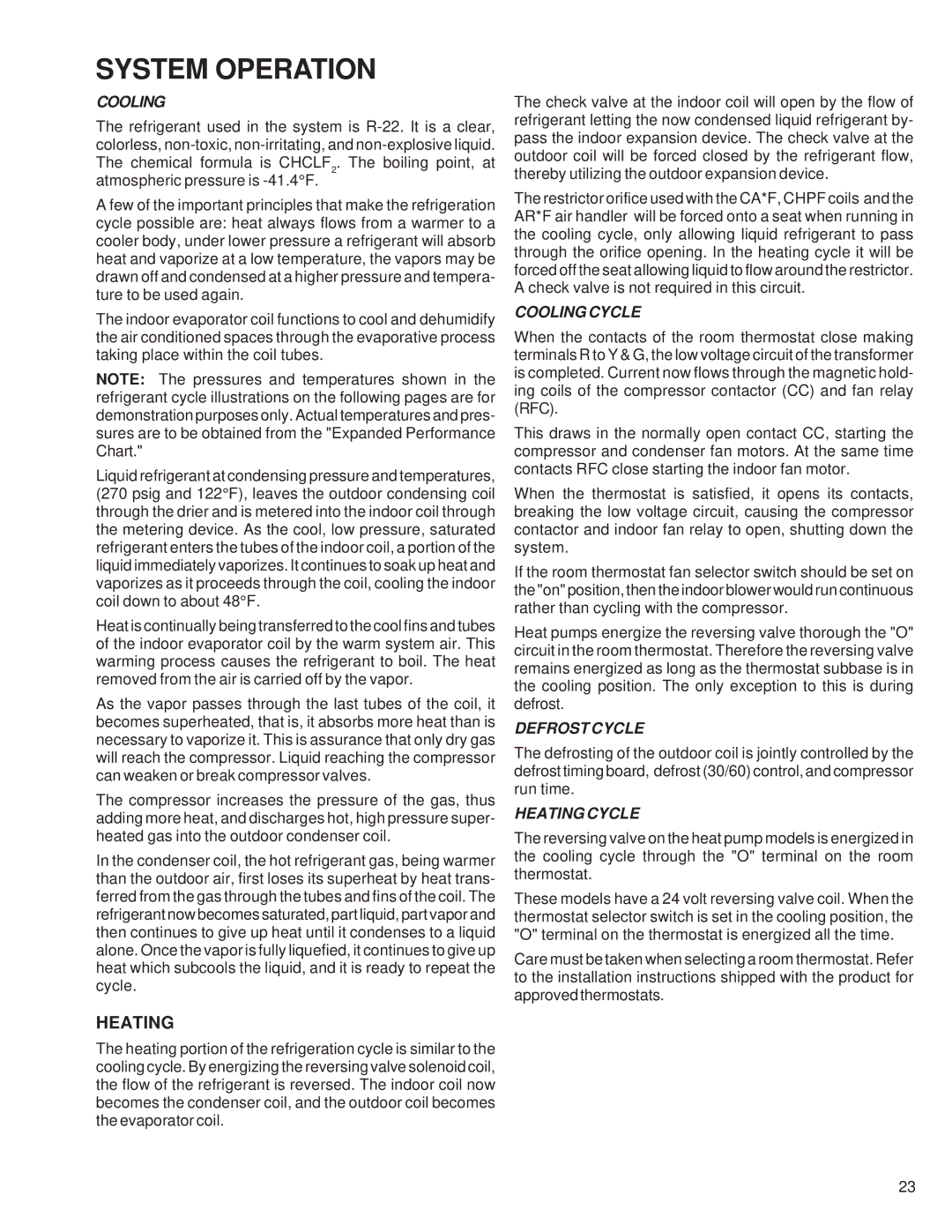SYSTEM OPERATION
COOLING
The refrigerant used in the system is
A few of the important principles that make the refrigeration cycle possible are: heat always flows from a warmer to a cooler body, under lower pressure a refrigerant will absorb heat and vaporize at a low temperature, the vapors may be drawn off and condensed at a higher pressure and tempera- ture to be used again.
The indoor evaporator coil functions to cool and dehumidify the air conditioned spaces through the evaporative process taking place within the coil tubes.
NOTE: The pressures and temperatures shown in the refrigerant cycle illustrations on the following pages are for demonstration purposes only. Actual temperatures and pres- sures are to be obtained from the "Expanded Performance Chart."
Liquid refrigerant at condensing pressure and temperatures, (270 psig and 122°F), leaves the outdoor condensing coil through the drier and is metered into the indoor coil through the metering device. As the cool, low pressure, saturated refrigerant enters the tubes of the indoor coil, a portion of the liquid immediately vaporizes. It continues to soak up heat and vaporizes as it proceeds through the coil, cooling the indoor coil down to about 48°F.
Heat is continually being transferred to the cool fins and tubes of the indoor evaporator coil by the warm system air. This warming process causes the refrigerant to boil. The heat removed from the air is carried off by the vapor.
As the vapor passes through the last tubes of the coil, it becomes superheated, that is, it absorbs more heat than is necessary to vaporize it. This is assurance that only dry gas will reach the compressor. Liquid reaching the compressor can weaken or break compressor valves.
The compressor increases the pressure of the gas, thus adding more heat, and discharges hot, high pressure super- heated gas into the outdoor condenser coil.
In the condenser coil, the hot refrigerant gas, being warmer than the outdoor air, first loses its superheat by heat trans- ferred from the gas through the tubes and fins of the coil. The refrigerant now becomes saturated, part liquid, part vapor and then continues to give up heat until it condenses to a liquid alone. Once the vapor is fully liquefied, it continues to give up heat which subcools the liquid, and it is ready to repeat the cycle.
HEATING
The heating portion of the refrigeration cycle is similar to the cooling cycle. By energizing the reversing valve solenoid coil, the flow of the refrigerant is reversed. The indoor coil now becomes the condenser coil, and the outdoor coil becomes the evaporator coil.
The check valve at the indoor coil will open by the flow of refrigerant letting the now condensed liquid refrigerant by- pass the indoor expansion device. The check valve at the outdoor coil will be forced closed by the refrigerant flow, thereby utilizing the outdoor expansion device.
The restrictor orifice used with the CA*F, CHPF coils and the AR*F air handler will be forced onto a seat when running in the cooling cycle, only allowing liquid refrigerant to pass through the orifice opening. In the heating cycle it will be forced off the seat allowing liquid to flow around the restrictor. A check valve is not required in this circuit.
COOLING CYCLE
When the contacts of the room thermostat close making terminals R to Y & G, the low voltage circuit of the transformer is completed. Current now flows through the magnetic hold- ing coils of the compressor contactor (CC) and fan relay (RFC).
This draws in the normally open contact CC, starting the compressor and condenser fan motors. At the same time contacts RFC close starting the indoor fan motor.
When the thermostat is satisfied, it opens its contacts, breaking the low voltage circuit, causing the compressor contactor and indoor fan relay to open, shutting down the system.
If the room thermostat fan selector switch should be set on the "on" position, then the indoor blower would run continuous rather than cycling with the compressor.
Heat pumps energize the reversing valve thorough the "O" circuit in the room thermostat. Therefore the reversing valve remains energized as long as the thermostat subbase is in the cooling position. The only exception to this is during defrost.
DEFROST CYCLE
The defrosting of the outdoor coil is jointly controlled by the defrost timing board, defrost (30/60) control, and compressor run time.
HEATING CYCLE
The reversing valve on the heat pump models is energized in the cooling cycle through the "O" terminal on the room thermostat.
These models have a 24 volt reversing valve coil. When the thermostat selector switch is set in the cooling position, the "O" terminal on the thermostat is energized all the time.
Care must be taken when selecting a room thermostat. Refer to the installation instructions shipped with the product for approved thermostats.
23
